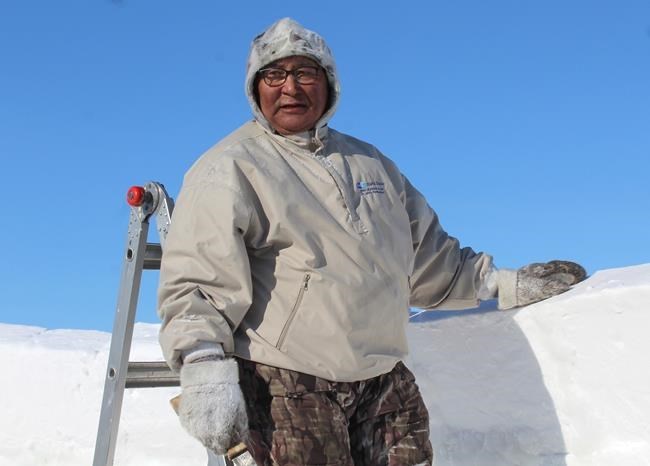IQALUIT — Solomon Awa thinks he’s probably built about 150 igloos, or igluit in Inuktitut, over his lifetime, starting when he was 15.
Now in his 60s, Awa is considered a master igloo builder in Nunavut.
On a sunny afternoon in Iqaluit, he slices a long, thin knife through blocks of solid snow, carving them to fit snugly in an igloo's walls. He steps back, squinting in the warm sun, to eye his progress, a thin layer of frost on his face.
Awa says igloo-building is traditional knowledge that has been passed down through generations of Inuit. There's no blueprint.
"It's all up here," he says, poking a finger at his head beneath his sealskin hat.
But Awa has never built an igloo this big.
Last week, he led a team of 12 men in building a 65-square-metre giant igloo, called a qaggiq or gathering place, over four days. It's about as big as a studio apartment.
The qaggiq was built to hold a two-day music and arts festival that took place over the weekend. The festival was hosted by Qaggiavuut, an Iqaluit-based organization that is advocating for the creation of a performing arts centre in Nunavut.
"I've never done anything like this before," said Awa, balancing on a folding ladder and shaving the top off a snow block he'd just added to the wall.
Alex Flaherty, owner of the Iqaluit guiding company Polar Outfitting, recruited his team to help Awa and Qaggiavuut. In total, Flaherty thinks they cut out about 700 blocks weighing about 36 kilograms each.
"At one point we just lost count of how many we cut out," he said.
The structure of an igloo is sort of like a snail shell, Flaherty explained. It starts with thicker blocks at the bottom and spirals into thinner ones as it gets to the top. The blocks are sealed together with ice by adding water in the cracks and smoothing it down.
"Eventually it's going to come down to one block."
Flaherty said no one in the group had ever built anything of that size.
The qaggiq is about 14 blocks high. At one point during building, the walls got so high that regular ladders wouldn't reach, so the men stacked their qamutiik, or traditional sleds, and climbed up.
Pitseolak Pfeifer, Qaggiavuut's executive director, said a qaggiq is a place of celebration. It's the perfect venue to not only share performances, but also to welcome spring.
"It's a place to hold a festival, to share culture as Inuit," Pfeifer said.
Artists from all over Nunavut performed over the weekend, including drum dancers from Cambridge Bay and a theatre group from Pond Inlet.
Looee Arreak, a singer-songwriter from Pangnirtung and the festival's artistic director, said it was the first time the artists would have performed in a qaggiq, although the idea isn't new.
"These traditional songs, the drums, the throat singing, were first introduced in a qaggiq. It is very special," Arreak said.
"It kind of makes me emotional. The architecture of the igloo itself brings so much pride to our culture."
Pfeifer said he never thought holding a festival inside an igloo in the middle of a pandemic would be possible.
He said Qaggiavuut received permission from the territory's chief public health officer. There are no cases of COVID-19 in Iqaluit.
"This might be the only place in Canada where we're able to hold a festival," Pfeifer quipped.
"If we have to play outside, perform outside, we can do it. But Nunavut deserves a performing arts centre. Inuit are amazing performers. It carries us through our lives."
Back at the qaggiq, it's -45 C with the wind chill outside, but Awa and his team are laughing, facial hair turning to icicles as they build higher and higher.
This report by The Canadian Press was first published March 22, 2021.
___
This story was produced with the financial assistance of the Facebook and Canadian Press News Fellowship
Emma Tranter, The Canadian Press



